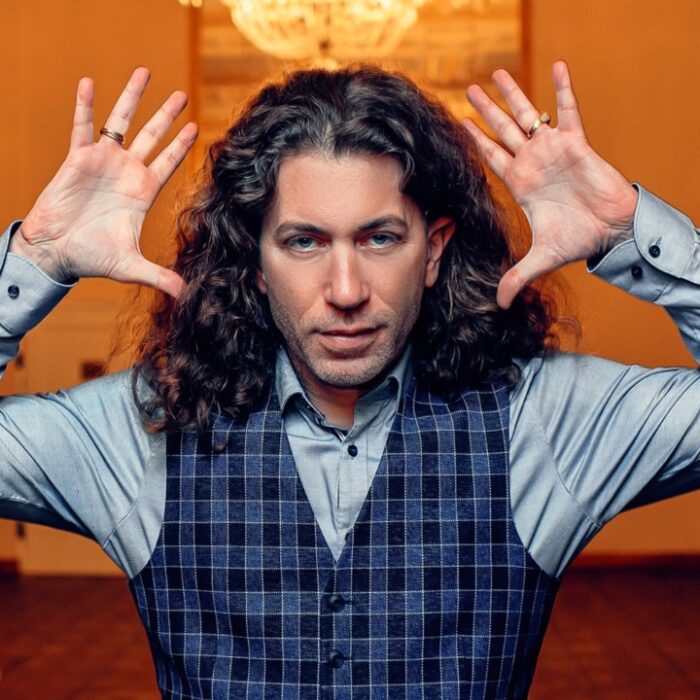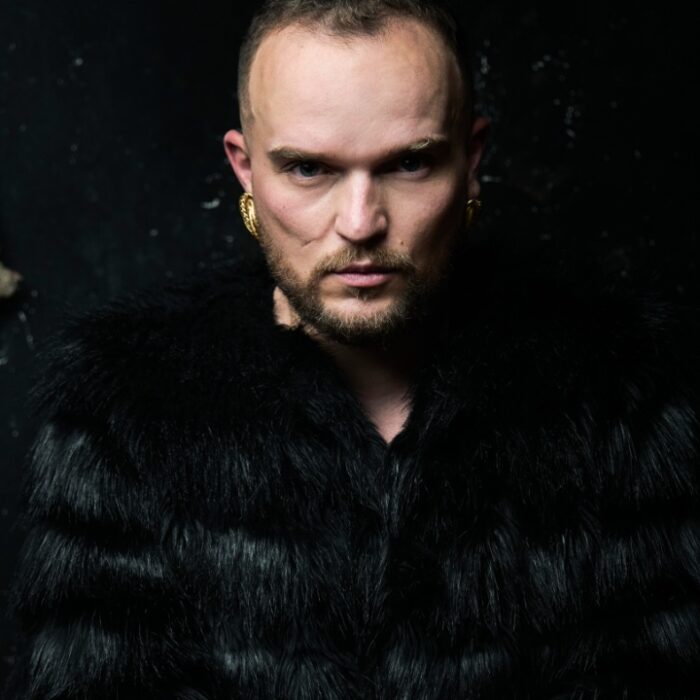
Q & A: Emma O’Halloran on ‘Mary Motorhead’ & ‘Trade’ at Irish National Opera
By Alan Neilson(Photo: Alex Dowling)
During the pandemic, the composer, Emma O’Halloran, and librettist, Mark O’Halloran, produced a piece for Irish National Opera’s hugely successful and innovative “20 Shots of Opera.” The work, entitled “The Wait,” is an impressive opera that brilliantly showcased O’Halloran’s compositional skills, in which OperaWire drew attention to her “wonderfully evocative score, with its contrasting densities and textures, dark coloring, silences (and) repetitive rhythms.” Unfortunately, it is only a very short piece, lasting approximately seven minutes, and was not performed live because of COVID restrictions.
However, audiences will now have the chance to see two of O’Halloran’s longer operas at this year’s Kilkenny Arts Festival, where Irish National Opera will kick off its 2024 – 25 season with the Irish premiers of “Mary Motorhead” and “Trade,” which will be presented as a double bill. During October, it will then embark on a tour across Ireland, playing in Dublin, Cork, Tralee, Ennis and Navan for a total of seven performances.
OperaWire was lucky enough to meet up with the composer for an interview about her musical career and the forthcoming productions of “Mary Motorhead” and “Trade.”
OperaWire: What were your early musical experiences, and how did you find your way into becoming a composer?
Emma O’Halloran: Even as a young child, I used to gravitate towards music. I suppose that it was my way of making sense of the world and of developing an understanding of myself. I think that is still the case today. I used to dance, and I also had flute lessons. It was a short step from playing tunes to making simple tunes, although I can’t remember any of them now, and I doubt that they were very good. I just loved anything to do with music. I was a very noisy child, and my parents must have hated it.
I never heard any live classical music until I was about 16. The National Youth Orchestra of Ireland was doing a tour, and when it passed through our town, I went along to see it what it was all about. At that point, I had no sense of what classical music was, but I was absolutely taken aback. I remembered they played John Adams “Short Ride in a Fast Machine.” So, I was quite late coming to classical music.
Even after this, I still found opera intimidating and didn’t go to see my first opera until much later on. I think this had at least one positive effect; it meant I came to the opera with a fresh, open attitude, as I had no understanding of the weight of the tradition involved. It was a performance of “Jenufa” in Prague while on a school trip. To be honest, I don’t remember too much about it, but I do recall the set designs, which were astonishing. I also remember thinking it was amazing that someone had conceived of such an art form.
Obviously, now I go to see opera as often as possible, particularly contemporary opera, which I love. Part of this is because I want to see what my fellow composers are doing. They can be very inspiring, and even operas I don’t particularly like often have something to intrigue me. Every opera, no matter whether good or bad, is a statement. They are able to open your mind to new ideas and present things in a way that you have never thought of before.
After I left university, I just followed my nose and hoped I could make a living composing, but I wasn’t sure. Fortunately, I received the commission to write “Trade” just as I finished my doctorate, and it was enough to keep me going for a while. This became the first opera I wrote as a professional composer, after which it became a case of making further contacts through word of mouth.
OW: Was “Trade” your first opera?
EO’H: Actually, “Trade” wasn’t my first opera; I had already written “Mary Motorhead.”
The Beth Morrison Project Next Generation initiative put out a call for scores, looking for new voices in opera, when I was in my final year at Princeton. Two of us were selected to write a 30-minute chamber opera, and I wrote “Mary Motorhead” and from that, I was chosen to write a full-scale opera, which became “Trade.”
OW: Where does opera fit into your work?
EO’H: I now consider it to be the most important part of what I do.
However, it took me some time to get involved with it. It was the form I didn’t know I needed, but now I love it. Obviously, I do other things as well, but there is something really special about opera.
With text involved, there are a lot of things you can do. I am really interested in capturing complex emotions in music. I like to think about them in terms of layers. Jealousy, for example, can be a mix of anger, sadness and bitterness. This is what I want to convey to an audience. Emotions also often change with time; you may be burning with rage, but this is likely to diminish. This is something that I want to convey through my music. I see emotions as the driving force of a story; it can be a magical process, and this is what I love about opera.
OW: So, can we expect many more operas from you in the future?
EO’H: Getting an opera off the ground can be very challenging. They are big ships to steer. However, I will write more, for sure. It is a great way to communicate with audiences, and I love to tell stories.
At the moment, I have two opera projects on the go, but both are only in the very early stages of development.
In the future, I am looking to expand the scope of what I am doing by making them longer, using bigger casts, and so on. I want to add new elements that allow me to develop and grow as a composer and learn how to navigate the process.
OW: Your librettist, Mark O’Halloran, is, I presume, a relative. Does this make for an easy working relationship?
EO’H: Yes, he is my uncle. When I was growing up, I didn’t really know him that well, but there is this shared family history, which I believe creates a bond of trust.
He is a fantastic writer, and I love his stuff. He has a very economic use of language, which I particularly appreciate. It might only be coincidence, but Mark does with words what I am trying to do with music; we are both trying to explore the human experience.
Sometimes, when you are in the writing process, you get into a state in which the music flows, and afterwards, it is hard to remember how you got to the point of arrival. Writing opera with Mark is like that. There is a lot of quick back-and-forth communication, and then the libretto will suddenly appear. To be honest, I don’t ask for many changes. With “The Wait,” for example, there were only one or two words that I wanted changed because I knew they wouldn’t sound good when sung, and he changed them without any problems.
I don’t actually send him any music, so he is as surprised as everyone else when I have finished it.
OW: How did “The Wait” come about?
EO’H: It was during the pandemic that Irish National Opera asked me for a short piece as part of their project “20 Shots of Opera.” I sent Mark a message, and he immediately came up with 10 ideas, from which I and Naomi O’Connell, who would be singing the piece, chose “The Wait.” I got back to Mark, and the next day the text arrived. He writes very quickly!
OW: “The Wait” is a very mysterious and disturbing piece. Was it deliberately created to make the audience work on understanding its meaning?
EO’H: Audiences are very smart these days. You cannot tell them what to think; that is insulting. However, having something that is open gives them a chance to reflect on the piece. For me, I want to know what happened in that woman’s life so that she won’t leave her house as the flood waters rise. Is it desperation? Is she waiting for someone to return? This is what makes opera so good; you can explore all these things in the music.
The horse thrashing about in the water is terrifying. The water is everywhere, and it is rising, but when the horse dies, it is very still. I found this a very interesting part, as it allowed me to think about how to convey the sound of water in music.
OW: What is the story of “Mary Motorhead” entail?
EO’H: Mark had originally written “Mary Motorhead” as a play, and I adapted it to create the libretto. I didn’t have money to pay Mark at the time, and he was very busy, and I was working on a very tight timeline, so with confidence born from ignorance, I thought I could do it myself; I mean, how difficult could it be to write a libretto?
Actually, I am very glad I did it because it made me appreciate how difficult a skill it is and how good Mark is at writing libretti.
“Mary Motorhead” is a monodrama about a woman who is serving an 18-year prison sentence in Mountjoy prison for committing a violent crime. She speaks directly to the audience, explaining that a person’s history is made up of known and unknown events. The known history consists of the main events, such as the crime Mary has committed, while the unknown history consists of all the small things that happen in our lives that shape and make us who we are. She relates her unknown history, informing us about her disappointments and betrayals that have occurred during her life, in the hope that the audience may understand why she did what she did. It is an outward-facing drama, and the music reflects this. It is telling the audience to sit back and listen to what she has to say.
OW: What is the story of “Trade” entail?
EO’H: “Trade” is almost the complete opposite of “Mary Motorhead.” Whereas she talks directly to the audience, in “Trade,” it is as if the audience has stumbled upon a conversation that it is not supposed to hear, and the music is used to draw in the listener.
It is about an encounter between two men in a room in a north Dublin guesthouse. There is a generational divide; one man is in his late 40s and the other is about 18 years of age, but in many ways, they are very similar. They are both fathers, both in heterosexual relationships, and both come from working-class backgrounds. The meeting is their shared secret, in which the older man pays the younger man for sex. The piece lasts about an hour and consists of a single conversation. We can infer that they have met before, but there is something different about this meeting. The older man shows up with blood on his shirt, and we don’t know why. However, over the course of the hour, a process of revealing takes place. They don’t communicate very well and find it difficult to share their emotions, but as they start drinking, they loosen up and start to reveal more about themselves. The older man has arrived to tell the younger man that he loves him, but for the younger man, it is just about money.
Like “Mary Motorhead,” it was originally written by Mark as a play. It was presented at the 2011 Dublin Theatre Festival, where it was staged in a guesthouse. It was all very intimate. A landlady opened the door and led the audience into a room, which accommodated about 30 people at a single showing, so not many people saw it.
OW: Your operas seem to contain quite a dark element. Does this reflect your character?
EO’H: Actually, I am quite a joyful person.
I do remember reading these lines from a poem,
“The deeper the sorrow that’s carved into your being, the greater the joy you can contain.”
It is something I can relate to. I know that I process emotions very deeply. In the last two weeks of writing Trade, for example, I cried continuously because it was so heartbreaking. I think maybe this is what allows me to be such a happy person.
OW: You appear to have a close working relationship with the singer Naomi O’Connell. How did this come about, and what is it about her performances that you admire?
EO’H: She was recommended to me by one of my college professors when I was considering writing “Mary Motorhead.” I reached out to her, and she asked me to send her the play, and she loved it. I wanted to write something that she would enjoy singing, so I asked her about her voice, such as where her passaggio lies, what she likes to sing and what she can do that other singers struggle with. She told me that she loves cabaret and that she can easily move from song to spoken text and back again, which many singers can’t manage. It was only when I had a good understanding of her voice that I started to write.
The more I have gotten to know Naomi, the more I have gotten to know her voice, and so by the time I came to write “The Wait,” I had a good feel for the music that suited her.
I love her as a performer; she has the ability to bring out the complexities of a character, which is great for Mary Motorhead, who can be very violent at one moment, then thoughtful the next.
I would like to work with her for the rest of my life. She is so talented. In fact, she is actually in the early stages of writing a libretto for me at the moment.
OW: You have seen both “Mary Motorhead” and “Trade” performed before. What are your expectations for the forthcoming run of performances from Irish National Opera?
E’OH: This is the third outing for “Mary Motorhead,” and I am particularly excited by it. When a new work is first performed, the focus tends to be on how successful or unsuccessful it is. I think that following the runs in New York and Los Angeles, this assessment has been made, so now it will be possible to look at it in a different, maybe deeper, way to see what else can be discovered about the piece. We are using the same conductor, Elaine Kelly, and director, Tom Creed, and I know they have had many thoughts about the work since they last worked on it. Elaine told me that she has discovered so many things about the orchestration since we last performed it, and I can’t wait to hear it.
The same is true for “Trade,” although it will have a new cast, which means a new energy, and I know that they are already fully engaged and have so many questions. It is a very exciting time for me, and I really hope that audiences are going to like both works.



